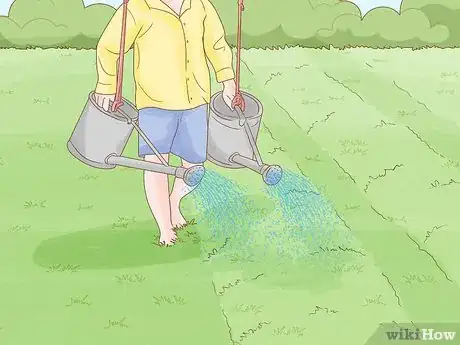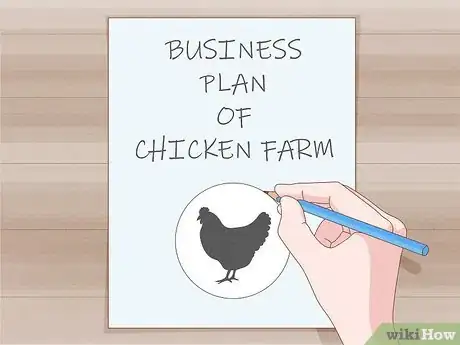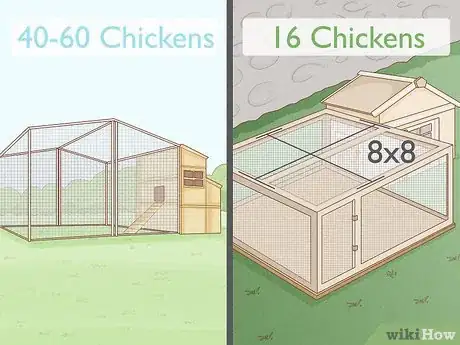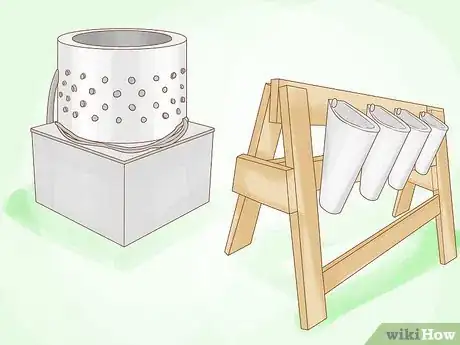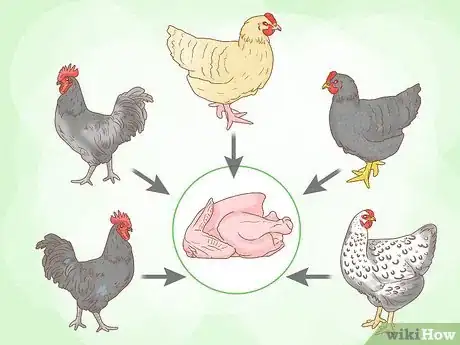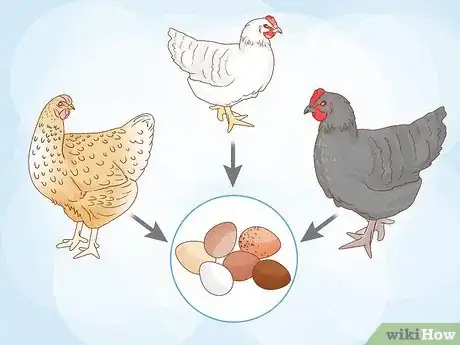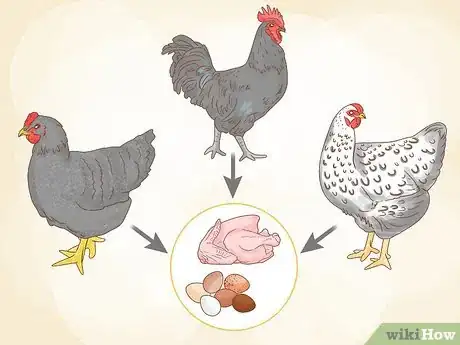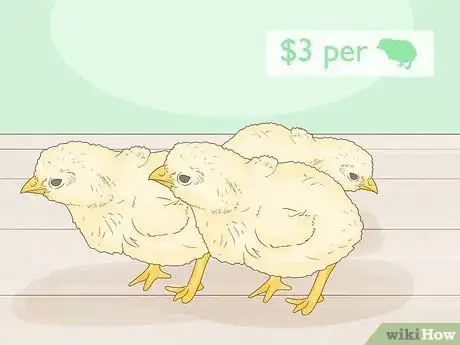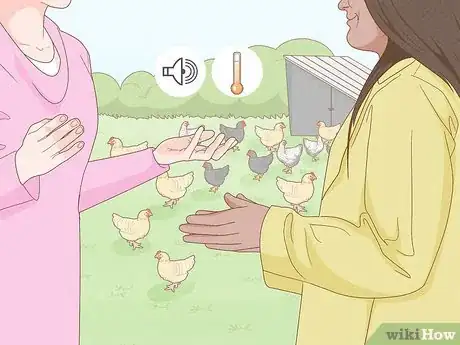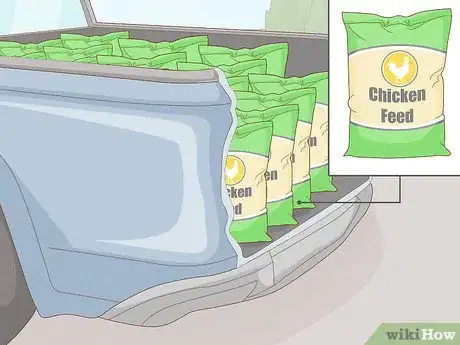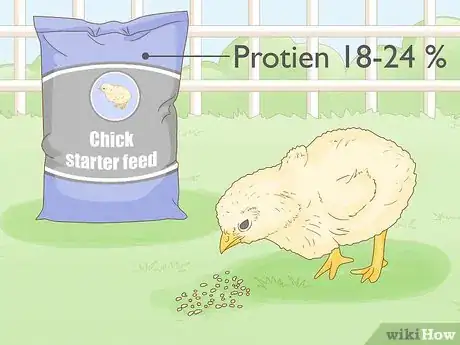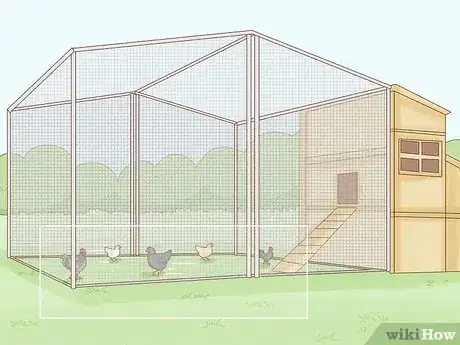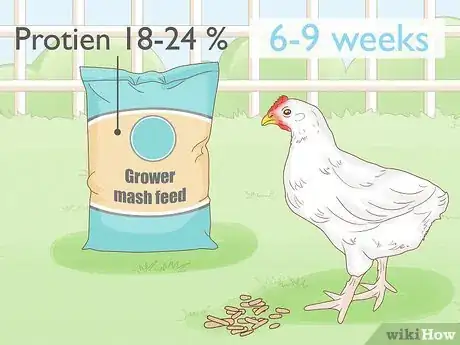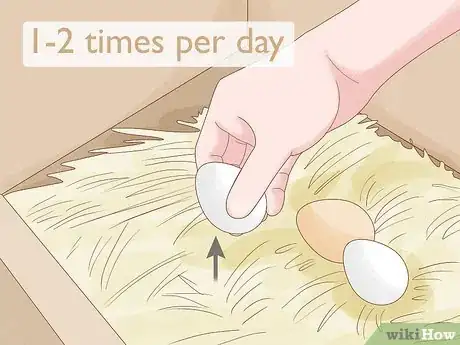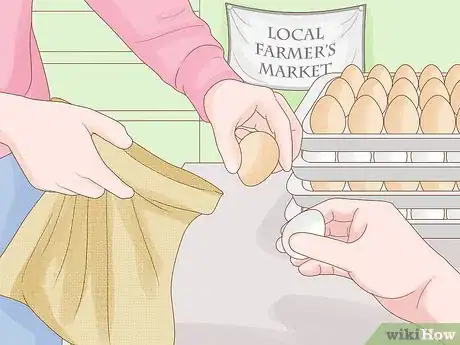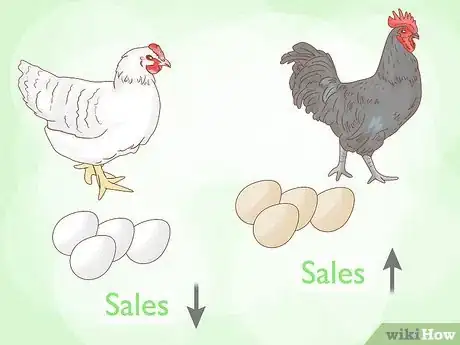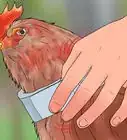This article was co-authored by wikiHow Staff. Our trained team of editors and researchers validate articles for accuracy and comprehensiveness. wikiHow's Content Management Team carefully monitors the work from our editorial staff to ensure that each article is backed by trusted research and meets our high quality standards.
There are 11 references cited in this article, which can be found at the bottom of the page.
wikiHow marks an article as reader-approved once it receives enough positive feedback. This article received 23 testimonials and 93% of readers who voted found it helpful, earning it our reader-approved status.
This article has been viewed 298,026 times.
Learn more...
Are you tired of heading to the grocery store for suspect eggs and frozen chicken every week? Small scale chicken farming has been growing in popularity among hobbyists as a sustainable way to have eggs and chickens always on hand. The start-up costs for a chicken farm are reasonable and can be made back if you decide to start selling your eggs to friends, neighbors, and at the local farmer’s market.[1] Before you can have eggs to sell, you will need to establish your business, set up the chicken coop, purchase chickens, and take good care of the chickens in your new farm.
Steps
Business Establishment
-
1Understand the skills and abilities required to start a chicken farm. Farming is known to be hard work, driven by a practical point of view and a commitment to long work hours. As a beginner farmer, you should be aware of the skills, abilities, and expectations required of you so you are prepared to start your farming endeavor with a good sense of what the role entails.[2]
- As a farmer, you will need to be willing to work long hours, including weekends, very early mornings, and likely late nights. You will also need to be prepared for physical work, where you are feeding, cleaning, shoveling, and caring for your chickens on a constant basis.
- You will also need to be prepared for seasonal earnings, where your profits are dependant on when your hens lay and how well you market and sell the meat and eggs produced by your chickens. This may mean your profits will be on the low end during your first year as a chicken farmer and you may need to wait one to two years to turn any significant profits from your farm.
- As a chicken farmer, you may need to be patient and be okay with setbacks or first time mistakes. You will then need to problem solve issues by fixing it yourself and relying on your abilities as a doer.
-
2Create a business plan for your chicken farm. Set your farm up for success by creating a business plan. Your business plan should include:
- Farm expenses: This is the cost of your equipment, the cost of your feed, the cost of your chicken coop(s), and the cost of your chickens. You should also consider the cost of the insurance premiums for the farm and if you need to pay for labor in the form of workers or employees to help you maintain the farm.
- Farm income: This should be made up of profit goals, where you have a certain amount of profit you will need to hit on a month to month basis. It’s important to have profit goals so you can sustain a certain income from the farm and ensure you turn a profit.
- Financing: To get the farm off the ground, you will need some form of financing or capital. This could be in the form of a savings account, borrowing money from a business partner or family, and/or grants or loans from government agencies. You may also have cash-flow through another source of income, like a part time job or another farming endeavor, that can be used to pay for expenses and keep your farm running.
- Disaster plan: As any farmer knows, the weather or a bad season can lead to low profits. You should have a disaster plan in place in the event of an emergency to ensure you can survive a bad year or a bad turn of events. Outline changes you can make to your farm to help you save money and stay in business in the event of a disaster. You may also want to have a succession plan in place, such as a will, in the event of a fatal incident.
Advertisement -
3Apply for financing. Unless you have a large amount of money in your savings account or access to start up funds through family or friends, you will have to apply for financing through a third party. This could be through a government program that provides grants for beginner farmers or through a loan from your local bank.[3]
- Most banks are partnered with local agencies that provide financing for start up farms, through Aggie Bond programs and the USDA. If you do not own the land you are farming on, you may be able to create a contract with the landowner in exchange for coverage of your equipment and start up costs.
- Look into the Farm Credit Services of America for Young and Beginning loans. These are made for farmers 35 years or younger, with 10 years or less of experience. Youth in Agriculture Loans also offers up to $2,500 for young farmers who are still students. You can find a complete list of farm loan programs on the Farm Service Agency’s website.[4]
- Check if your state has a tax-free bond program to provide funding for beginner farmers. You should also check with the USDA Farm Service Agency, which can lend you money to get your farm off the ground.
-
4Work with a farming organization to get hands on experience as a farmer. If you would like to get a better sense of the work environment and the expectations in the farmer role, you may want to spend some time working with a farming organization like WWOOF (World Wide Opportunities on Organic Farms).[5]
- These positions often cover your room and board on the farm in exchange for working on the farm. You can also get hands on experience in the life of farming for a longer period of time, which will better prepare you to start your own farm.
Chicken Farm Setup
-
1Decide if you are going to do coop farming or pastured farming. There are two options when it comes to chicken farming: farming your chickens in a coop or farming your chickens in a pasture. When you set up a coop chicken farm, you will need to have coops, buildings, and large equipment to take care of the chickens. Pastured farming only requires a small acreage of land and an enclosure so the birds are protected from predators. The benefits of pastured farming are that there is very little overhead or start up costs and it can be done with fifty chickens or hundreds of chickens.
- Many of the other elements of chicken farming, like selecting chickens and caring for the chickens, are the same for both coop farming and pastured farming. The major difference in pastured farming is that rather than build a coop for the chickens, you will need small enclosed shelters on a pasture. The chicks, feed, and water will then be moved everyday in movable pens.
- You can also set up a pastured farm using a shelter that has a door that allows the chicks to move in and out of the shelter at will. You will then surround the shelter with electric fencing and move the fencing on occasion so the chicks are given access to new areas to pasture.
-
2Build a coop big enough to house forty to sixty chickens. The most important element of your chicken farm is the chicken coop, which should be big enough to fit forty to sixty chickens at a time. Chickens are social animals and do well in groups. The coop should be big enough to provide four square feet of space per chicken. For example, an 8 x 8 chicken coop can hold 16 chickens. The coop should also be large enough for you to stand in so you can gather eggs and shovel manure. But do not make it too big, as the chickens can get cold in a space that is too large.
- Most chicken coops are built out of wood, with wood roofs and chicken wire windows and a chicken wire door. The windows or screens are important as they will allow sunlight into the coop in the wintertime and provide ventilation in the summertime. You can buy the raw materials and build it yourself using a chicken coop plan.
- If you do not want to take the time to construct a coop, you can buy one at your local hardware or farm supply store. Coops can range from $500 for a small one to $3000 for a larger size.
-
3Include a large roosting area and nesting boxes. Your coop must include a roost for your chickens, about 6-12 inches of roosting space allotted for each bird. You can build the roost inside the coop using a board or dowel that is 1 ½ inches in diameter, making sure the roost is 2 ½ - 3 feet off the coop floor.
- The coop should also have a nesting box for the chickens, 13 inches all around, one box per four to five birds. The nesting boxes will keep the eggs laid off the coop floor and away from the manure.
-
4Add a feeder and water containers. Finally, make sure the coop has a feeder that is big enough for the chickens to eat from and several water containers that are shallow so the chickens cannot fall into them. You should have one long feeder per four to six birds and one water container per four to six birds.[6]
-
5Fence in a 20 x 5 foot outdoor area near the coop with chicken wire and a chicken fence. Your chickens will need an outdoor area to walk and cluck around in so they can spread their wings and take dust baths throughout the day. A chicken run will help your chickens stay healthy and ensure they produce high quality eggs. You should fence the area with chicken wire or put up a chicken fence so the chickens stay in and are not threatened by predators, including any household cats or dogs.[7]
- Try to have the outdoor area close or next to the chicken coop for easy access and convenience. The chickens will spend a lot of time in the outdoor area and in the coop so they should be close to each other.
- You should fortify the chicken wire with fencing using T-posts to keep predators out and line the base of the enclosures to ensure no small animals like weasels, minks or snakes from getting into the enclosure.
-
6Buy an incubator if you plan to breed your own chickens. If you plan to breed your own chickens, you should get one to two incubators to help keep your new chicks warm and well cared for.[8]
- Keep in mind incubators can be expensive and often take up lots of space. You can find incubators at your local farm equipment store or online through second hand websites.
-
7Get stainless steel killing cones and a feather plucker to process your meat chickens. You should be prepared to process any chickens raised for meat by investing in stainless steel killing cones and a feather plucker. This will make the processing time for each chicken fast and efficient.[9]
- If you do not want to invest in this type of equipment, you can use a hatchet and a scalding pot instead to kill and process your chickens. However, larger meat chicken farms often have more sophisticated equipment to keep production easy and fast.
-
8Invest in egg washing equipment for egg laying chickens. In order to sell chicken eggs commercially, you will need to have egg-washing equipment to clean the eggs properly. You will also need to have a professionally calibrated scale so you can size your eggs properly and a high intensity candler to grade your eggs.[10]
- You should also invest in egg cartons and egg labeling. Your labeling should advertise that your eggs are all natural, locally produced, and pesticide and chemical free as this will attract more customers to your eggs.
Chicken Selection
-
1Go for Ranger or Heritage breeds if you are raising the chickens for meat. If you are focused on getting meat from your birds, you may want to go for the Ranger breed, which grows moderately fast and are more active than the American white broiler birds that are popular in the chicken industry. These birds are full grown in about 12 weeks.[11]
- Heritage breeds like Jersey Giant, Wyandottes, Rocks and Australorps, are also good meat chickens and are good dual purpose birds, where you can procure both meat and eggs. They are slow growing but are known to be healthy and tasty. A heritage breed chicken can be ready in 6-8 months.
-
2Choose Black star, Red star, or White Leghorn breeds if you are raising the chickens for eggs. Most egg laying breeds will have smaller bodies than meat producing breeds and can lay white or brown eggs. There is no difference between white or brown eggs besides the color of the eggs. Many white egg layers are of the Leghorn breed and many brown egg layers are of the Rhode Island Red breed. White Leghorns, Black star, and Red star are all popular egg laying breeds, which can lay 320-340 eggs a year.[12]
-
3Consider dual purpose breeds if you want meat and eggs from your chickens. Some chicken breeds are considered dual purpose, where you can get both meat and eggs from them with the proper care. Most first time chicken farmers go for dual purpose breeds if they are planning to have both eggs and meat.
- Popular dual purpose breeds include Orpingtons, Rocks, Wyandottes, Australorps, Rhode Island Reds, and Sussex varieties. You will need to have a rooster in your flock if you have dual purpose breeds, one rooster for every eight to twelve hens.
- Most dual purpose breeds take about three to four weeks to produce eggs and are “broody”. This means the hens of these breeds will sit on the eggs and hatch the chicks, thereby replenishing your flock without the need to buy new chicks or hatch the eggs yourself.
-
4Buy young chicks if you are prepared to wait for eggs or meat. You can buy chickens at several different stages of development from a breeder: day-old chicks, ready-to-lay pullets, and mature laying hens. Young, day-old chicks take the longest to grow and raise and you will need to wait about six months for eggs, but they are cheap, about $3 each from a hatchery. Invest in forty to sixty chicks if you are planning on running a larger scale chicken farm. You may want to start with only twelve to fourteen chicks if you are planning on running a small scale chicken farm on your land.[13]
- Ready-to-lay pullets are 20 weeks old and are more expensive than day-old chicks. But they are just starting to lay, meaning they will produce eggs sooner. They are also usually females and can go straight into your coop for roosting and laying.
- It is is difficult to get mature laying hens, as they are usually only available if a chicken farmer wants to sell their old hens and replace them.
-
5Ask the breeder about the noise level and temperament of the chickens before buying them. You can buy your chickens from a local hatchery, which should be run by a knowledgeable breeder. You should ask the breeder about the noise level of the birds, if they are docile or very active, and if they are good in a confined space. The breeder should be able to recommend a breed based on your coop size and farm set up.
- You should also ask the breeder if the chickens are high-laying and how long they will take to lay eggs or reach maturity for meat. For example, some breeds are calm, docile, and high-laying, like the Jersey Giant, but require more room in the coop due to their size. Other breeds are not as docile, but are quiet and good with confinement, like the Araucanas, but they produce green colored eggs rather than the standard white or blue. The breeder should be forthcoming about all of this information before you buy any chickens from him.
Daily Care and Egg Collection
-
1Buy feed in bulk. Feed can be one of the most expensive supplies for running a chicken farm, but it is also the most essential element. Good high quality feed can ensure your chickens are healthy and their products taste good. While you may be tempted to allow your chickens to forage in pasture to reduce your feed costs, this will likely lead to a coop of hungry chickens and less eggs produced. Instead, buy enough feed in bulk to last you two months. This will allow you to save money and ensure you do not run out of feed for your chickens.[14]
-
2Give young chicks starter feed. Most backyard chicken farms start with a flock of baby chicks, so it is important that you give the chicks the right amount of nutrients and care so they grow into full, healthy chickens. Look for chick starter feed at your local farm supply store. Chick starter feed usually comes in a mash or crumble form and contains a protein content of 18-24%, which helps the chicks to gain muscle and weight.[15]
- Give the chicks just starter feed once a day for the first two days, then introduce chick grit into their feeders on the third day. This will help them digest their food better. You can give them grit until they reach maturity and switch to oyster shell once they start to lay eggs. All chick breeds will consume around three pounds of starter feed during the first three weeks in the coop.
- You should make sure the water troughs are not too deep in the coop, as the chicks can drown in them. They should be shallow and cleaned daily. Have about a one gallon-sized waterer for every hundred chicks. If you have pullets, you can use one waterer for every six to eight birds.
-
3Use a brooder lamp to keep the coop warm. Chicks will need a red brooder lamp on at all times in the coop and no drafts or cold areas to grow properly. The temperature of the coop should be around 92 degrees Fahrenheit. Once the chicks start to feather out, you can reduce the temperature in the coop by five degrees per week until they are six weeks old.[16]
- Make sure the chicks are close to water and food in the coop. You can do this by spreading four inches of pine shavings on the coop floor and then several layers of newspaper. Scatter chick feed on the paper so it is easy to access and make sure the feeding trough is full of feed. Remove one layer of paper a day until the chicks are comfortable using the feeding trough.
-
4Ensure there is enough room in the coop to prevent picking. Picking is common among chicks and chickens in coops, as well as cannibalism and pecking to death. You can prevent this by making sure there is enough space in the coop for all of your chickens.[17]
- You can try to mix the ages of your flock and keep them in one coop, with older chickens living with young chicks. They should not pick at each other as long as there is enough space in the coop for all of them.
-
5Switch to grower mash feed once the chicks start to feather out, at about six weeks. If you are raising a fast growing breed, you will need to give the birds grower mash feed that has 18-24% protein content until they are ready for processing, about six to nine weeks. These fast growing birds can consume about 20 pounds of feed from the age of three weeks to processing at six to nine weeks.
- If you have Heritage breed chickens or Ranger breed chickens, you should give them a grower mash with an 18-21% protein content to ensure they grow healthy and full. Ranger breeds can consume 25 pounds of feed from the age of three weeks to butchering time, about 11-12 weeks old.
- Egg laying breeds will need a grower mash with a 17-20% protein content until they begin to lay eggs at five months old. Switch to grower feed with a protein content of 15-17% with a supplement of oyster shell once they start to lay, as this will allow the hens to produce strong egg shells.
-
6Collect eggs once to twice a day. Once your chickens have matured and are ready for laying, you can start to collect eggs from their roosting area. As long as they have access to 12 to 14 hours of light, most hens will lay eggs in the spring, summer and into fall.[18]
Marketing and Selling Tips
-
1Consider your target audience. Think about who is going to buy your products. Perhaps you specialize in a specific chicken breed and feel you can market it to high end restaurants in your area. Or, you may be able to sell eggs at a lower price than your competitor. Do some research and visit your local farmer’s markets to see what types of eggs and meats are selling. You should also look at the menus of local restaurants and see if you can fill a gap in their supplies.[19]
- You should also think about how you are going to get your products to your target audience. If your target audience seems to be more at local farmer’s markets, you should have all the supplies necessary to package and sell your products. If your target audience seems to be more in restaurants or the dining industry, you may need to consider using a nearby processing plant that is USDA-approved to ensure you can fulfill large orders for these clients.
-
2Advertise online to potential buyers. To turn a profit with your farm, you will need to focus on marketing your products to local food vendors and suppliers in your area. This will allow you to turn a bigger profit, selling larger units of your products, and to build working relationships with your buyers. Get the word out by advertising your products online and using local online databases that are setup to connect buyers with local farms.[20]
- You can also create a Facebook page for your farm and update it regularly with announcements and photographs of the farm. This can act as free marketing for you and allow you to connect to buyers outside of your local area.
- You may want to consider creating business cards and a business website for your farm. This will allow you to advertise your farm and keep your customers informed on changes or updates in your products.
-
3Sell your products at local farmer’s markets. Many chicken farmers will focus on local customers and sell their products at farmer’s markets in their area. This is a good option for beginning farms as it usually requires a very short travel time and you can build a customer base every week at the same markets.
- Your products should be properly labeled, with your farm logo or name, and notes on being locally farmed and preservative free. If you use organic feed for your chickens or if you pasture your chickens, you should also note this on the packaging. This will entice customers who are health conscious and environmentally conscious to buy your products.
-
4Adjust your chicken selection based on the sales of your products. After several weeks to months of selling your products to your target audience, you should re evaluate your chickens. Note if one product from one chicken breed is selling more than the same product from a different chicken breed. Consider adjusting your chicken selection so you have more chickens who produce eggs and meat that sell well. This will ensure your farm is sustainable and responding to the needs of your customers.
Community Q&A
-
QuestionHow do I deal with poultry disease and curing it?
 Community AnswerWell, you can't really cure it. The best thing that you can do is to remove the sick poultry from its flock until it's better, therefore containing the illness before it spreads to your other poultry.
Community AnswerWell, you can't really cure it. The best thing that you can do is to remove the sick poultry from its flock until it's better, therefore containing the illness before it spreads to your other poultry. -
QuestionHow can I prevent chicken diseases?
 Community AnswerKeep them fit and healthy and separate from other birds.
Community AnswerKeep them fit and healthy and separate from other birds. -
QuestionHow can I start a poultry production?
 Community AnswerContact the department of agriculture in your state to get started.
Community AnswerContact the department of agriculture in your state to get started.
References
- ↑ http://www.beginningfarmers.org/information-about-raising-chickens/
- ↑ https://newfarmers.usda.gov/important-considerations
- ↑ http://www.cfra.org/resources/beginning_farmer/fundingsources
- ↑ http://www.fsa.usda.gov/programs-and-services/farm-loan-programs/
- ↑ http://www.wwoof.net/
- ↑ http://www.almanac.com/blog/raising-chickens/raising-chickens-101-building-backyard-coop
- ↑ http://www.backyardpoultrymag.com/financial_considerations_for_starting_a_small-scale_poultry_farm/
- ↑ http://www.backyardpoultrymag.com/financial_considerations_for_starting_a_small-scale_poultry_farm/
- ↑ http://www.backyardpoultrymag.com/financial_considerations_for_starting_a_small-scale_poultry_farm/
- ↑ http://www.backyardpoultrymag.com/financial_considerations_for_starting_a_small-scale_poultry_farm/
- ↑ https://www.knowyourchickens.com/meat-chickens/
- ↑ http://extension.msstate.edu/publications/choosing-the-right-breed-for-your-backyard-flock
- ↑ http://www.almanac.com/blog/raising-chickens/raising-chickens-101-bring-baby-chicks
- ↑ http://www.backyardpoultrymag.com/financial_considerations_for_starting_a_small-scale_poultry_farm/
- ↑ http://www.scoopfromthecoop.com/whats-chick-starter/
- ↑ http://www.almanac.com/blog/raising-chickens/raising-chickens-101-bring-baby-chicks
- ↑ http://www.almanac.com/blog/raising-chickens/raising-chickens-101-bring-baby-chicks
- ↑ http://www.almanac.com/blog/raising-chickens/raising-chickens-101-bring-baby-chicks
- ↑ https://newfarmers.usda.gov/important-considerations
- ↑ http://www.backyardpoultrymag.com/financial_considerations_for_starting_a_small-scale_poultry_farm/
About This Article
To start a chicken farm, create a business plan and secure financing for your farm. Next, build a coop big enough for 40 to 60 chickens and create a large roosting area. Make sure there are enough nesting boxes for all of your chickens and the boxes provide 6-12 inches of roosting space for each bird. Next, choose and buy the chicken breed you want to raise, then determine your target audience and how you're going to sell your chicken products to them! For tips on marketing and selling your products, read on!
